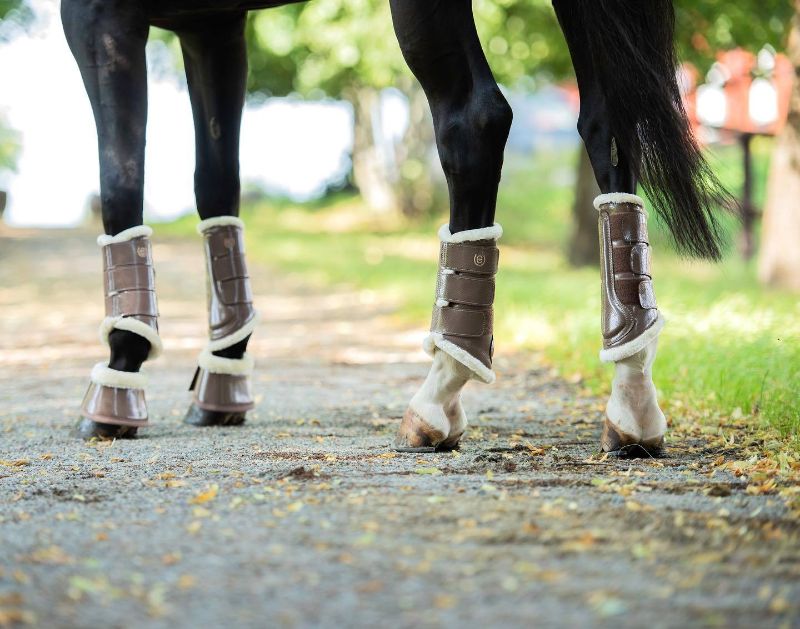These are most commonly used by showjumpers to protect the ligaments of the horse’s leg. They wrap around the fetlock and along the back of the cannon bone, where the most sensitive and high-impact areas are on a horse’s leg. While jumping a course, there is a lot of suspension needed by the suspensory and deep digital flexor tendon as a horse is coming off a fence at high speed. The fetlock will drop to absorb the impact of the horse’s body, while the hind legs come over the fence and brace for impact as well. At high speeds, whether it be on the downfall of a jump or galloping around the course in between fences, there can be a certain degree of overreaching. This is where the open front boots become so much more important, as they consist of a hard shell that shields the precious ligaments from the hind hooves when they overreach and cause an impact on that portion of the front legs.
There are many brands that make open front boots, some more expensive than others, but a few of my personal favorites consist of:
- Veredus
- Eskadron
- Shedrow
- Equifit (although this brand does use leather as the hard outer shell which can cause some issues when on a horse that is known to overreach a fair amount)
- Acavallo
- Back On Track
There is also an open-front hind boot that has the same necessity as the open-front but is used less often and not seen as being detrimental to the safety of the horse while flatting or jumping a course. When looking for hind boots for competition, there should be some thought given to what is the best option for your horse and which boot follows the rules and regulations now set out by the FEI.
Standing wraps
A standing wrap has a wide variety of uses ranging from rehabilitation to protection while traveling. Traditionally a ‘No Bow’ bandage is placed underneath, which is a thicker cotton wrap that helps aid in the prevention of bowing the tendons in both the front and hind legs. Wrapping a horse’s legs should only be done by someone confident in their wrapping skills, as when done improperly, it can cause a bow within the tendon. This happens when uneven pressure is applied to the horse’s ligament side of the leg, which creates a bubbling effect known as the bow. This is a difficult injury to treat and normally requires a vet visit along with stall rest.
Standing wraps can be purchased from your local tack store. There are many brands in which standing wraps are made, but personally, I find it more important to find a set of No Bow cotton (which can also be purchased at the local tack store) that makes you feel comfortable and confident when wrapping your horse. They come in a wide variety of thicknesses and lengths, but if you find ones that fit your horse well, then you’re set.
The best way to wrap a horse in a standing wrap and no bows is to first start with the no bows. It is not important to have these as tight as possible, but just to have them lay straight on the lower leg from fetlock up. They should then be wrapped following a pattern of behind, away, towards, pull taut. Behind and away, meaning place the bandage on the right dorsal aspect of the leg and wrapping towards the head of the horse, from posterior to anterior. Towards and pull taunt references the motion of pulling the wrap taunt across the cannon bone of the horse’s limb, which is found on the ventral aspect of the distal limb.
These wraps should be redone every 12 hours, if not more often. They are very practical and prove to be a great tool in reducing inflammation on injured or just plain exhausted, over-extended legs. When not to use them, however, or to use caution is when:
- The horse fancies them in their mouth rather than on their legs. This is when bowing the tendon can become a risk as the horse is placing uneven pressure on the ligaments.
- It is extremely hot, and there is a risk of causing further exhaustion to the horses’ legs as they are unable to cool themselves appropriately.
- Due to time constraints or availability, no one can reset the wraps within the maximum 12-hour time frame.
If this is the case, then an alternate option may be Sports Medicine Boots.
SMB
Sports medicine boots have proven time and time again how useful they are in many areas that standing wraps are lacking. They can provide an adequate amount of compression and stability to the ligaments, and they are a more discrete boot as they are quite a bit less bulky. These seem to be a popular option for those in the western world, and while I am more of an English fan myself, I still found these to be quite helpful while rehabbing my jumper from a suspensory injury when she began to go outside again.
They are also a great option for those who do not feel comfortable wrapping their own horses in polo wraps, as they are what one might call dummy-proof. They easily cup around the fetlock of the horse’s leg, and as long as you do not get the left and right confused, it is quite easy to apply the Velcro strap around the front of the cannon bone towards you at whatever pressure is desired. These can be worn on both hind legs and front legs.
Professionals Choice makes a great option and is affordable in pricing, and has a wide variety of colors to suit even the most vibrant of personalities.
Polo Wraps
Next up are polo wraps. These can be used for a wide variety of reasons and have been seen in all settings, ranging from a horse out for a quiet hack to the Grand Prix show jumping ring. While their level of protection differs from the open front and the SMB, they are similar to the standing wrap in that they are placed onto the horse’s leg very similarly. While the standing wrap consists of no bows and a long slender wrap over the top, polo wraps are just slender wrap that can be applied directly to the horse’s leg as an aid in compression all the way to stability.
I have two favorite polo wraps, and while they are on the more expensive side of the wide range that is available, there are specific reasons why I find them to be the best.
- The Equifit Essential polo wrap. These have a grippy side that allows for a more stable wrap without the risk of slippage, which can happen in almost all wraps after exercise, no matter who tight they are placed.
- The Climatex Eskadron wrap. These have what mimics a no bow made out of absorbent material that can allow for the horse to sweat and the skin to breathe, which deters the risk of overheating and skin infections. Halfway down, the wrap is a stretchy tensor bandage-like material that can assist in creating a perfect, secure wrap.
Brush Boots
Brush boots can be used by dressage riders as an everyday boot that protects the inside of the leg from getting caught by both overreaching or by the tight movements made by dressage horses in training. They have also been proven useful to protect a horse from itself while being turned out to pasture. They are a fairly safe option for protection from everyday life.
Shedrow makes an excellent, affordable option that does its job and can stand up to the wildest of ponies.
Cross Country Boots
These boots can be compared to that of the open front boot, but instead of having exactly that, they are able to cover and protect the cannon bone as well from natural obstacles that a horse may come across on the cross-country field.
Bell Boots
These boots protect the horse’s front hooves from damage due to the back hooves overreaching and clipping their heels. Similar to brush boots, once a pair has been found that fits the horse properly, they can be worn as protection from themselves and can be found in all competition rings except for the hunter ring.
Written by Allison Shaw, Hospital Assistant.
Learn more about Allison Shaw here.


